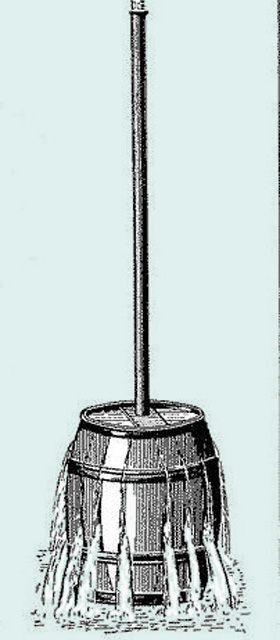Pascal's law facts for kids
Pascal's law is a rule in physics that explains how pressure works in liquids. It says that if you push on a liquid that is trapped inside a container, that push (or pressure) will spread out equally in all directions throughout the liquid. This amazing idea was discovered by a brilliant French scientist named Blaise Pascal in 1647. You can see Pascal's law in action when a fluid moves from one syringe to another through a connecting tube.
Contents
What is Pascal's Law?
Pascal's law helps us understand how liquids behave when they are squeezed. Imagine you have a balloon filled with water. If you press on one side of the balloon, the water inside doesn't just move away from your hand. Instead, the pressure you apply spreads evenly through all the water, pushing outwards on every part of the balloon.
Pressure in Liquids
Pressure is a force pushing on an area. In liquids, this pressure can be very powerful. Pascal's law tells us that if a liquid is "incompressible" (meaning it can't be squished into a smaller space) and it's in a closed container, any pressure you add to it will be felt everywhere in that liquid. It's like magic, but it's science!
Who Was Blaise Pascal?
Blaise Pascal was a French mathematician, physicist, inventor, writer, and philosopher. He lived from 1623 to 1662. Pascal was a child prodigy, meaning he was incredibly smart from a young age. He made many important discoveries in science and mathematics.
Pascal's Contributions
Besides Pascal's law, he also invented an early calculator called the Pascaline. He did important work in geometry and probability theory. His work on fluids, especially Pascal's law, laid the groundwork for many modern technologies we use today.
How Does Pascal's Law Work?
Think about a toothpaste tube. When you squeeze one end, toothpaste comes out the other end. The pressure you apply with your fingers is transmitted through the toothpaste (a fluid) to the opening. This is a simple example of Pascal's law.
The Principle Explained
The key idea is that the pressure doesn't get weaker as it travels through the fluid. It stays the same everywhere. This is why hydraulic systems are so powerful. A small force applied to a small area can create a very large force on a larger area.
Real-Life Examples of Pascal's Law
Pascal's law is used in many everyday machines and systems. It's a fundamental principle behind how many hydraulic devices work.
Hydraulic Brakes in Cars
One of the best examples is the braking system in a car. When you press the brake pedal, you push a small piston. This piston creates pressure in the brake fluid. According to Pascal's law, this pressure is transmitted equally through the fluid to larger pistons at each wheel. These larger pistons then push the brake pads against the wheels, slowing the car down. A small push from your foot creates a huge stopping force!
Hydraulic Lifts and Jacks
Have you ever seen a car being lifted high up at a repair shop? This is done using a hydraulic lift. A small pump creates pressure in a fluid, which then pushes a large piston upwards. Because of Pascal's law, a small force from the pump can lift a very heavy car. Hydraulic jacks, used to change tires, work on the same principle.
Water Guns and Syringes
Even simple toys like water guns use Pascal's law. When you push the plunger, you create pressure on the water inside. This pressure pushes the water out of the nozzle with force. Syringes also work this way, allowing medicine to be pushed out evenly.
Pascal's Barrel Experiment
Blaise Pascal famously demonstrated his law with an experiment called "Pascal's Barrel." He took a very tall, thin tube and attached it to a sealed barrel full of water.
The Experiment Setup
Pascal poured only a small amount of water into the tall tube. Even though it was just a little bit of water, the pressure it created at the bottom of the very tall column was enormous.
The Surprising Result
The pressure from that small amount of water was enough to burst the strong wooden barrel! This showed how a small force applied over a large height (creating high pressure) could have a dramatic effect, proving that pressure is transmitted throughout the fluid.
Images for kids
See also
 In Spanish: Principio de Pascal para niños
In Spanish: Principio de Pascal para niños



